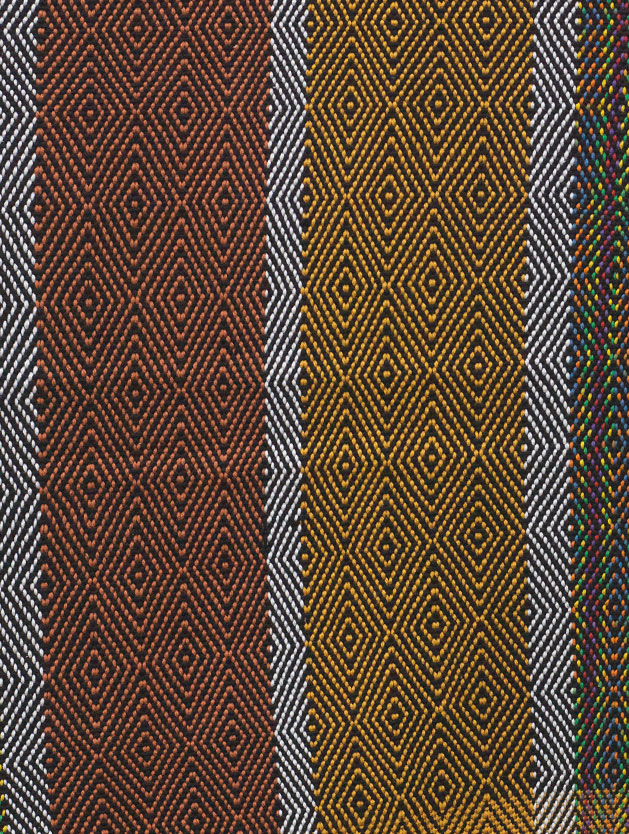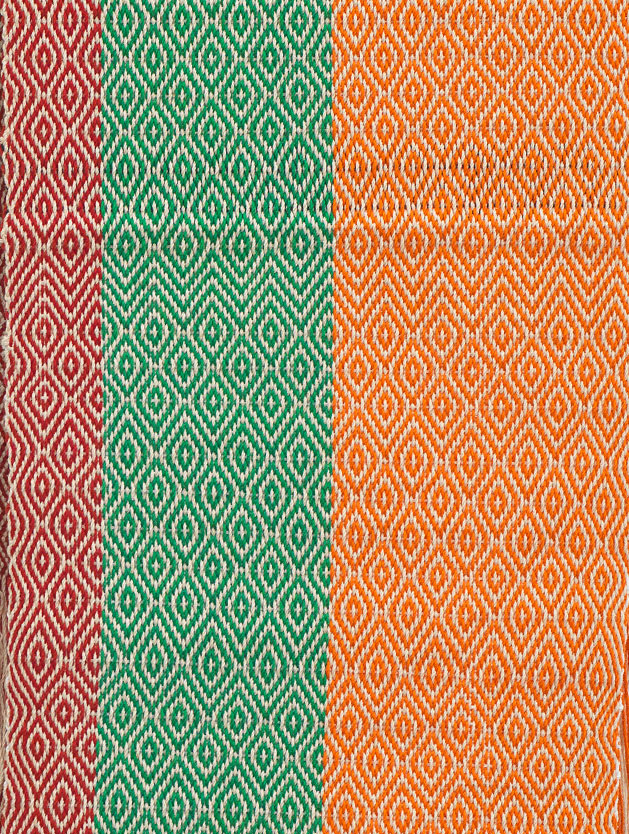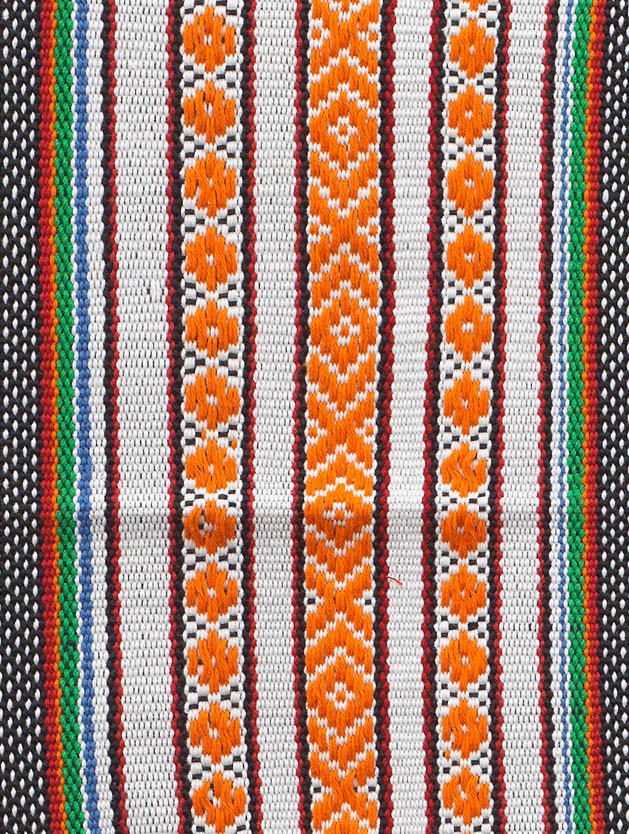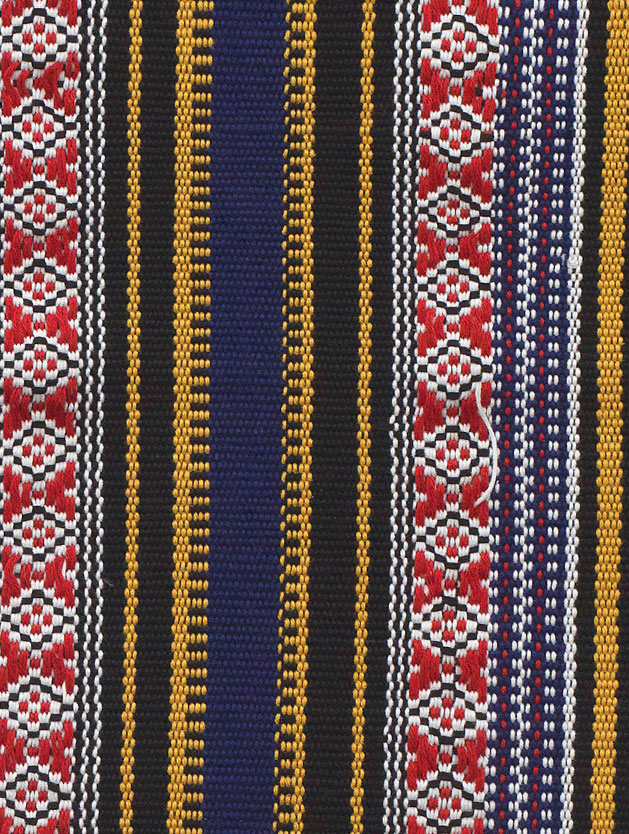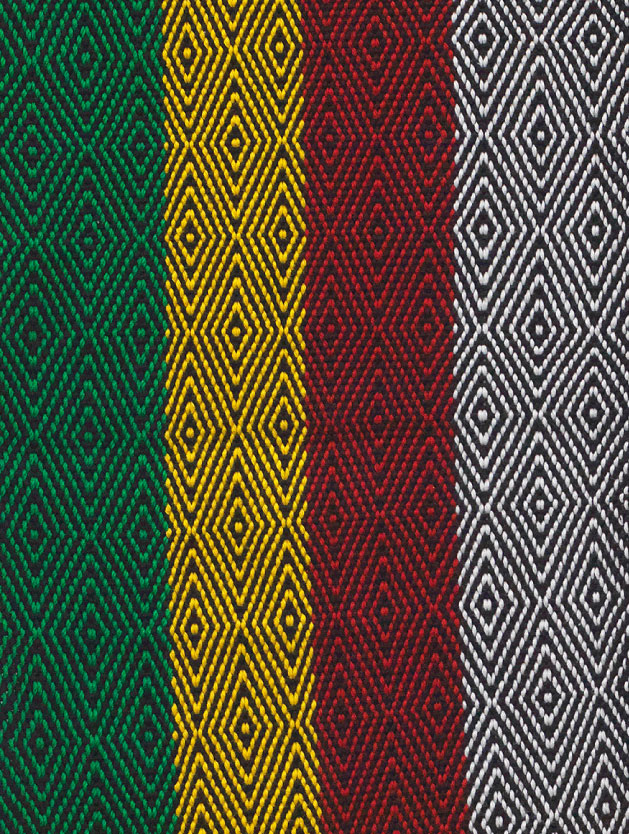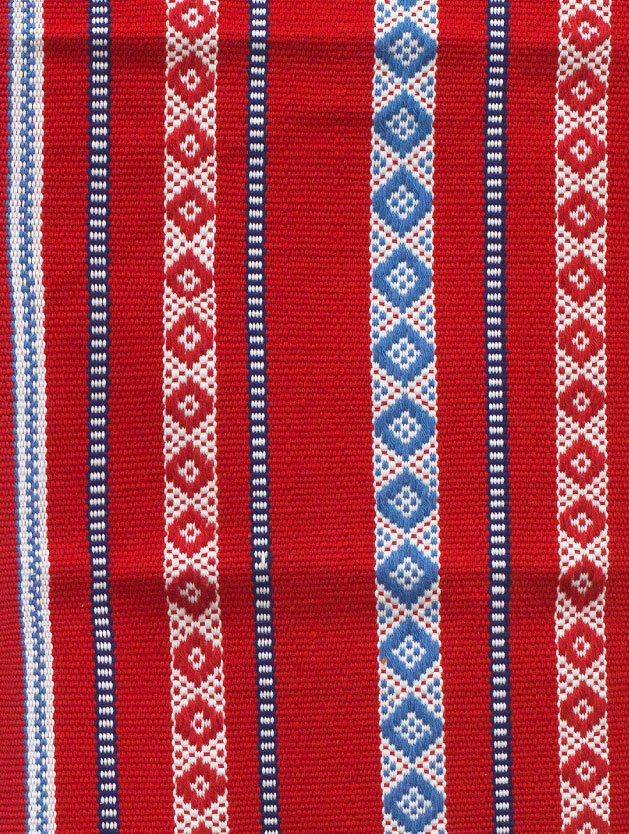
王素貞織品 Wang Su-zhen
織品1 Textile #1
作者 王素貞 Author Shen Mei-lu
媒材 織品 Medium Textile
文化 泰雅族 Culture Paiwan
作品賞析 Artwork Appreciation
藝術家王素真擁有八分之一的排灣族血統,認識部落織布啟蒙老師尤佑耆老之後,在烏來開啟了編織泰雅傳統織布的創作道路。在排灣族的傳統紋飾裡頭,他開始尋覓何為泰雅織布,在排灣族朋友的鼓勵之下,前往烏來學習有關平織的工作坊,實踐了自己對原民文化的熱愛,進而開始研究探索,了解原民色彩的美,搭配特有的圖文,在經緯線內穿梭,也找到自己的個人創作風格。王素真所呈現的藝術世界,是種神秘的美、難以言喻的美,是傾向一種「精神上的崇高」,也包含族人緬懷祖先的感恩和傳承下來的記憶。創作作品裡,常出現的菱形紋,代表保佑和傳承,更是烏來屈尺群祖先的特有手藝。透過傳統織布也開啟了傳統與現代的連結,找回對原民文化的人認同與感動。
Wang Su-zhen, who is herself 1/8 Paiwan, has a long and abiding love and loyalty for the culture of Taiwan’s Indigenous peoples. She was fortunate to meet Ulay Tribe weaver and elder Yuyoh Peilin who set her on the creative path of traditional Atayal weaving. Within the ornamental traditions of the Atayal, Wang thus began her search for a deeper understanding of its weaving culture. With the encouragement of her Atayal friends, Wang traveled to Wulai to participate in several weaving workshops. During this period, she actualized her deep appreciation for the culture of Indigenous peoples through the research and exploration of the colors, patterns, and the uniquely personal styles of the warp and weft of Atayal weavings. Weaving among Taiwan’s Indigenous peoples is a distinct cultural tradition, one imbued with an attitude of remembrance and gratitude towards a tribe’s ancestors, as well as serving as a communal memory marker connecting one generation to the next. Diamond shaped pattens are a common theme in Atayal weavings and carry connotations of protection and the inheritance of tradition. As a pattern, they are also distinctly representative of the craftsmanship traditions of Atayal’s Taiyaru Tribe who call the area around Wulai their home. Through such traditional weavings, a connection between tradition and modernity is established, while a recognition and appreciation of Indigenous peoples’ cultures is reawakened.
織品2 Textile #2
作者 王素真 Author Shen Mei-lu
媒材 織品 Medium Textile
文化 排灣族 Culture Paiwan
作品賞析 Artwork Appreciation
藝術家王素真擁有八分之一的排灣族血統,認識部落織布啟蒙老師尤佑耆老之後,在烏來開啟了編織泰雅傳統織布的創作道路。在泰雅族的傳統紋飾裡頭,他開始尋覓何為泰雅織布,在泰雅族朋友的鼓勵之下,前往烏來學習有關平織的工作坊,實踐了自己對原民文化的熱愛,進而開始研究探索,了解原民色彩的美,搭配特有的圖文,在經緯線內穿梭,也找到自己的個人創作風格。王素真所呈現的藝術世界,是種神秘的美、難以言喻的美,是傾向一種「精神上的崇高」,也包含族人緬懷祖先的感恩和傳承下來的記憶。創作作品裡,常出現的菱形紋,代表保佑和傳承,更是烏來屈尺群祖先的特有手藝。透過傳統織布也開啟了傳統與現代的連結,找回對原民文化的人認同與感動。
Wang Su-zhen, who is herself 1/8 Paiwan, has a long and abiding love and loyalty for the culture of Taiwan’s Indigenous peoples. She was fortunate to meet Ulay Tribe weaver and elder Yuyoh Peilin who set her on the creative path of traditional Atayal weaving. Within the ornamental traditions of the Atayal, Wang thus began her search for a deeper understanding of its weaving culture. With the encouragement of her Atayal friends, Wang traveled to Wulai to participate in several weaving workshops. During this period, she actualized her deep appreciation for the culture of Indigenous peoples through the research and exploration of the colors, patterns, and the uniquely personal styles of the warp and weft of Atayal weavings. Weaving among Taiwan’s Indigenous peoples is a distinct cultural tradition, one imbued with an attitude of remembrance and gratitude towards a tribe’s ancestors, as well as serving as a communal memory marker connecting one generation to the next. Diamond shaped pattens are a common theme in Atayal weavings and carry connotations of protection and the inheritance of tradition. As a pattern, they are also distinctly representative of the craftsmanship traditions of Atayal’s Taiyaru Tribe who call the area around Wulai their home. Through such traditional weavings, a connection between tradition and modernity is established, while a recognition and appreciation of Indigenous peoples’ cultures is reawakened.
織品3 Textile #3
作者 王素真 Author Shen Mei-lu
媒材 織品 Medium Textile
文化 排灣族 Culture Paiwan
作品賞析 Artwork Appreciation
藝術家王素真擁有八分之一的排灣族血統,認識部落織布啟蒙老師尤佑耆老之後,在烏來開啟了編織泰雅傳統織布的創作道路。在泰雅族的傳統紋飾裡頭,他開始尋覓何為泰雅織布,在泰雅族朋友的鼓勵之下,前往烏來學習有關平織的工作坊,實踐了自己對原民文化的熱愛,進而開始研究探索,了解原民色彩的美,搭配特有的圖文,在經緯線內穿梭,也找到自己的個人創作風格。王素真所呈現的藝術世界,是種神秘的美、難以言喻的美,是傾向一種「精神上的崇高」,也包含族人緬懷祖先的感恩和傳承下來的記憶。創作作品裡,常出現的菱形紋,代表保佑和傳承,更是烏來屈尺群祖先的特有手藝。透過傳統織布也開啟了傳統與現代的連結,找回對原民文化的人認同與感動。
Wang Su-zhen, who is herself 1/8 Paiwan, has a long and abiding love and loyalty for the culture of Taiwan’s Indigenous peoples. She was fortunate to meet Ulay Tribe weaver and elder Yuyoh Peilin who set her on the creative path of traditional Atayal weaving. Within the ornamental traditions of the Atayal, Wang thus began her search for a deeper understanding of its weaving culture. With the encouragement of her Atayal friends, Wang traveled to Wulai to participate in several weaving workshops. During this period, she actualized her deep appreciation for the culture of Indigenous peoples through the research and exploration of the colors, patterns, and the uniquely personal styles of the warp and weft of Atayal weavings. Weaving among Taiwan’s Indigenous peoples is a distinct cultural tradition, one imbued with an attitude of remembrance and gratitude towards a tribe’s ancestors, as well as serving as a communal memory marker connecting one generation to the next. Diamond shaped pattens are a common theme in Atayal weavings and carry connotations of protection and the inheritance of tradition. As a pattern, they are also distinctly representative of the craftsmanship traditions of Atayal’s Taiyaru Tribe who call the area around Wulai their home. Through such traditional weavings, a connection between tradition and modernity is established, while a recognition and appreciation of Indigenous peoples’ cultures is reawakened.
織品4 Textile #4
作者 王素真 Author Shen Mei-lu
媒材 織品 Medium Textile
文化 排灣族 Culture Paiwan
作品賞析 Artwork Appreciation
藝術家王素真擁有八分之一的排灣族血統,認識部落織布啟蒙老師尤佑耆老之後,在烏來開啟了編織泰雅傳統織布的創作道路。在泰雅族的傳統紋飾裡頭,他開始尋覓何為泰雅織布,在泰雅族朋友的鼓勵之下,前往烏來學習有關平織的工作坊,實踐了自己對原民文化的熱愛,進而開始研究探索,了解原民色彩的美,搭配特有的圖文,在經緯線內穿梭,也找到自己的個人創作風格。王素真所呈現的藝術世界,是種神秘的美、難以言喻的美,是傾向一種「精神上的崇高」,也包含族人緬懷祖先的感恩和傳承下來的記憶。創作作品裡,常出現的菱形紋,代表保佑和傳承,更是烏來屈尺群祖先的特有手藝。透過傳統織布也開啟了傳統與現代的連結,找回對原民文化的人認同與感動。
Wang Su-zhen, who is herself 1/8 Paiwan, has a long and abiding love and loyalty for the culture of Taiwan’s Indigenous peoples. She was fortunate to meet Ulay Tribe weaver and elder Yuyoh Peilin who set her on the creative path of traditional Atayal weaving. Within the ornamental traditions of the Atayal, Wang thus began her search for a deeper understanding of its weaving culture. With the encouragement of her Atayal friends, Wang traveled to Wulai to participate in several weaving workshops. During this period, she actualized her deep appreciation for the culture of Indigenous peoples through the research and exploration of the colors, patterns, and the uniquely personal styles of the warp and weft of Atayal weavings. Weaving among Taiwan’s Indigenous peoples is a distinct cultural tradition, one imbued with an attitude of remembrance and gratitude towards a tribe’s ancestors, as well as serving as a communal memory marker connecting one generation to the next. Diamond shaped pattens are a common theme in Atayal weavings and carry connotations of protection and the inheritance of tradition. As a pattern, they are also distinctly representative of the craftsmanship traditions of Atayal’s Taiyaru Tribe who call the area around Wulai their home. Through such traditional weavings, a connection between tradition and modernity is established, while a recognition and appreciation of Indigenous peoples’ cultures is reawakened.
織品5 Textile #5
作者 王素真 Author Shen Mei-lu
媒材 織品 Medium Textile
文化 排灣族 Culture Paiwan
作品賞析 Artwork Appreciation
藝術家王素真擁有八分之一的排灣族血統,認識部落織布啟蒙老師尤佑耆老之後,在烏來開啟了編織泰雅傳統織布的創作道路。在泰雅族的傳統紋飾裡頭,他開始尋覓何為泰雅織布,在泰雅族朋友的鼓勵之下,前往烏來學習有關平織的工作坊,實踐了自己對原民文化的熱愛,進而開始研究探索,了解原民色彩的美,搭配特有的圖文,在經緯線內穿梭,也找到自己的個人創作風格。王素真所呈現的藝術世界,是種神秘的美、難以言喻的美,是傾向一種「精神上的崇高」,也包含族人緬懷祖先的感恩和傳承下來的記憶。創作作品裡,常出現的菱形紋,代表保佑和傳承,更是烏來屈尺群祖先的特有手藝。透過傳統織布也開啟了傳統與現代的連結,找回對原民文化的人認同與感動。
Wang Su-zhen, who is herself 1/8 Paiwan, has a long and abiding love and loyalty for the culture of Taiwan’s Indigenous peoples. She was fortunate to meet Ulay Tribe weaver and elder Yuyoh Peilin who set her on the creative path of traditional Atayal weaving. Within the ornamental traditions of the Atayal, Wang thus began her search for a deeper understanding of its weaving culture. With the encouragement of her Atayal friends, Wang traveled to Wulai to participate in several weaving workshops. During this period, she actualized her deep appreciation for the culture of Indigenous peoples through the research and exploration of the colors, patterns, and the uniquely personal styles of the warp and weft of Atayal weavings. Weaving among Taiwan’s Indigenous peoples is a distinct cultural tradition, one imbued with an attitude of remembrance and gratitude towards a tribe’s ancestors, as well as serving as a communal memory marker connecting one generation to the next. Diamond shaped pattens are a common theme in Atayal weavings and carry connotations of protection and the inheritance of tradition. As a pattern, they are also distinctly representative of the craftsmanship traditions of Atayal’s Taiyaru Tribe who call the area around Wulai their home. Through such traditional weavings, a connection between tradition and modernity is established, while a recognition and appreciation of Indigenous peoples’ cultures is reawakened.
織品6 Textile #6
作者 王素真 Author Shen Mei-lu
媒材 織品 Medium Textile
文化 排灣族 Culture Paiwan
作品賞析 Artwork Appreciation
藝術家王素真擁有八分之一的排灣族血統,認識部落織布啟蒙老師尤佑耆老之後,在烏來開啟了編織泰雅傳統織布的創作道路。在泰雅族的傳統紋飾裡頭,他開始尋覓何為泰雅織布,在泰雅族朋友的鼓勵之下,前往烏來學習有關平織的工作坊,實踐了自己對原民文化的熱愛,進而開始研究探索,了解原民色彩的美,搭配特有的圖文,在經緯線內穿梭,也找到自己的個人創作風格。王素真所呈現的藝術世界,是種神秘的美、難以言喻的美,是傾向一種「精神上的崇高」,也包含族人緬懷祖先的感恩和傳承下來的記憶。創作作品裡,常出現的菱形紋,代表保佑和傳承,更是烏來屈尺群祖先的特有手藝。透過傳統織布也開啟了傳統與現代的連結,找回對原民文化的人認同與感動。
Wang Su-zhen, who is herself 1/8 Paiwan, has a long and abiding love and loyalty for the culture of Taiwan’s Indigenous peoples. She was fortunate to meet Ulay Tribe weaver and elder Yuyoh Peilin who set her on the creative path of traditional Atayal weaving. Within the ornamental traditions of the Atayal, Wang thus began her search for a deeper understanding of its weaving culture. With the encouragement of her Atayal friends, Wang traveled to Wulai to participate in several weaving workshops. During this period, she actualized her deep appreciation for the culture of Indigenous peoples through the research and exploration of the colors, patterns, and the uniquely personal styles of the warp and weft of Atayal weavings. Weaving among Taiwan’s Indigenous peoples is a distinct cultural tradition, one imbued with an attitude of remembrance and gratitude towards a tribe’s ancestors, as well as serving as a communal memory marker connecting one generation to the next. Diamond shaped pattens are a common theme in Atayal weavings and carry connotations of protection and the inheritance of tradition. As a pattern, they are also distinctly representative of the craftsmanship traditions of Atayal’s Taiyaru Tribe who call the area around Wulai their home. Through such traditional weavings, a connection between tradition and modernity is established, while a recognition and appreciation of Indigenous peoples’ cultures is reawakened.
織品7 Textile #7
作者 王素真 Author Shen Mei-lu
媒材 織品 Medium Textile
文化 排灣族 Culture Paiwan
作品賞析 Artwork Appreciation
藝術家王素真擁有八分之一的排灣族血統,認識部落織布啟蒙老師尤佑耆老之後,在烏來開啟了編織泰雅傳統織布的創作道路。在泰雅族的傳統紋飾裡頭,他開始尋覓何為泰雅織布,在泰雅族朋友的鼓勵之下,前往烏來學習有關平織的工作坊,實踐了自己對原民文化的熱愛,進而開始研究探索,了解原民色彩的美,搭配特有的圖文,在經緯線內穿梭,也找到自己的個人創作風格。王素真所呈現的藝術世界,是種神秘的美、難以言喻的美,是傾向一種「精神上的崇高」,也包含族人緬懷祖先的感恩和傳承下來的記憶。創作作品裡,常出現的菱形紋,代表保佑和傳承,更是烏來屈尺群祖先的特有手藝。透過傳統織布也開啟了傳統與現代的連結,找回對原民文化的人認同與感動。
Wang Su-zhen, who is herself 1/8 Paiwan, has a long and abiding love and loyalty for the culture of Taiwan’s Indigenous peoples. She was fortunate to meet Ulay Tribe weaver and elder Yuyoh Peilin who set her on the creative path of traditional Atayal weaving. Within the ornamental traditions of the Atayal, Wang thus began her search for a deeper understanding of its weaving culture. With the encouragement of her Atayal friends, Wang traveled to Wulai to participate in several weaving workshops. During this period, she actualized her deep appreciation for the culture of Indigenous peoples through the research and exploration of the colors, patterns, and the uniquely personal styles of the warp and weft of Atayal weavings. Weaving among Taiwan’s Indigenous peoples is a distinct cultural tradition, one imbued with an attitude of remembrance and gratitude towards a tribe’s ancestors, as well as serving as a communal memory marker connecting one generation to the next. Diamond shaped pattens are a common theme in Atayal weavings and carry connotations of protection and the inheritance of tradition. As a pattern, they are also distinctly representative of the craftsmanship traditions of Atayal’s Taiyaru Tribe who call the area around Wulai their home. Through such traditional weavings, a connection between tradition and modernity is established, while a recognition and appreciation of Indigenous peoples’ cultures is reawakened.
